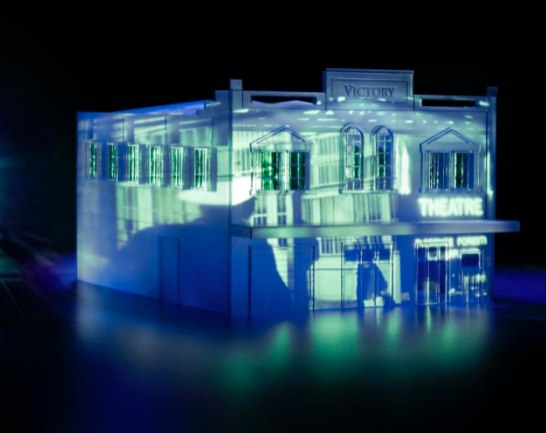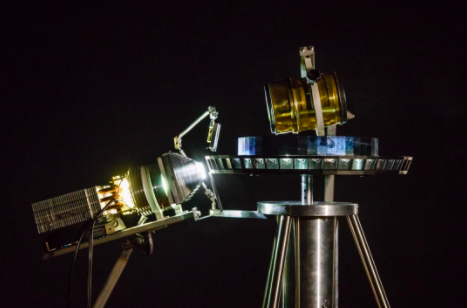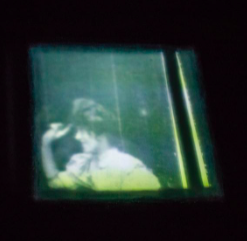Double-space: Creating optical image system artworks across Art and STEM
Deirdre Feeney
I have always been fascinated by the interaction of glass and light. Sitting in an echoey cathedral as a small child, I would fix my gaze on the stained-glass windows, eagerly awaiting the sun to reappear and illuminate the coloured figures, magically bringing them to life. These luminous figures never stayed visible for too long, the sun soon disappeared, and the figures vanished back into the darkness of their materiality. Years later when I learned to work with glass as a material for creative practice, I always combined it with projected image light. In my studio I meticulously ground, polished and kiln formed glass to construct miniature architectural structures as substrates for holding projected video-animations, which I called dreamscapes. Once full of life, these now abandoned buildings allowing themselves to sleep and dream, released fleeting memories which had been held within their glass walls.


As my practice evolved, glass and light continued to cast their wonderous spell on me, which I later discovered, was created through the combination of the material properties of glass and the invisible properties of light. After working with my glass structures and projected dreamscapes for some time, visiting an exhibition on the magic lantern at the Cinémathèque Française in Paris changed the course of my practice. Now, instead of using a data projector to invisibly transport the dreamscapes into my buildings’ glass walls, I wanted work with glass as part of the material mechanism which generates the image.
Initially developed in the seventeenth century, the magic lantern is essentially an image projector using a glass slide, lenses and light to project an image. As I stood in front of the lanterns at the Cinémathèque, their ‘magic’ seemed to emerge from what was simultaneously exposed and hidden from view. Although both the device and its projected image were in full view before me, my attention was naturally drawn to the luminous image which, with no perceptible connection to the lantern, appeared as if by magic. Even when I consciously attended to the lantern, I could not directly observe the image being transported to the screen. The transfer of image light was hidden in plain sight and it was this imperceptibility that seemed to hold the key to the lanterns’ magic.
The magic lantern led me to the intriguing world of optics to understand how the material of glass, when shaped and polished in a particular way, uncannily transports an image of an object across space and time. Until then I had always worked with digital images and data projectors, but now my interest shifted from digital to materially generated images and how light and specifically formed glass interact to create an image. Back in my studio I gathered lenses from various discarded optical devices and each time I held up one of the lenses in front of my studio window, the scene from outside was somehow magically projected onto the opposite wall. Although these images were small and inverted, the intensity and luminosity of the image-light always captivated me.



Similar to my experience of the magic lanterns at the Cinémathèque, in the studio my attention also focused on the projected image light and although I could see the lens and its projected image, I could not see the transfer of light from the scene outside travelling through the lens and onto my studio wall. Once again, I was grappling with what was seen and unseen and the natural direction of my attention.
I wanted to create a series of optical image devices exploring the visibilities and invisibilities of natural magic and wonder and so I began to seek out optical physicists who could help me understand the interactions of glass and light. Ironically, during my first meetings with various physicists and engineers they all asked me the same question: “why don’t you just use a data projector?” It wasn’t until they saw my optical device artworks finally come together that their question was answered.
Through the process of developing my optical image systems I gained multiple insights from scientists and engineers while simultaneously learning about the history of science and optical technologies. To help my discussions with the physicists I became familiar with geometric ray diagrams and different behaviours of light as it passes through different lenses. When collaborating with a quantum physicist who was also a skilled nano-optical fabricator, I discovered overlapping interests across art and science to materialise ideas, or perhaps more specifically in the case of the physicist, materialise mathematical ideas. Investigating the history of optics, I learned how Renaissance preternatural philosophers, although not scientists in a contemporary sense, used glass objects and projected images to move beyond medieval understandings of light and sight. I was intrigued by the optical illusions of the natural magician Giovanni Battista Della Porta and how he used lenses and mirrors to project images and manipulate the emotional experience of his enthralled audiences. I revelled in how the seventeenth century mathematician and lens maker Christiaan Huygens combined his tacit knowledge of glass with mathematics to work out the optics of the magic lantern and how he disowned his invention because of its undesirable connection to magic. But it was a conversation with an optical physicist in Ireland that converted me to the creative potential of the overlapping realm of art and science. After earlier exchanges to figure out why my projected images appeared in and out of focus, inverted, magnified, reduced in size and even to float in the air, the conversation transitioned to solving an issue I had recently encountered while developing my artwork Ghost in the Machine.



Ghost in the Machine explores the materiality of optical time and conjures a ghost of a character from an early silent film The Magical Press. Lost in the vaults of the National Film and Sound Archive, I aimed to use the material components of my image system to re-presence this forgotten protagonist in the form of a ghost. The device in Ghost in the Machine is based on a nineteenth century optical mechanism developed by artist and engineer Charles-Émile Reynaud. My previous artworks had incorporated concepts of real and virtual, loosely equating them with material and immaterial elements respectively. My limited context for real and virtual was turned on its head when the physicist explained the optical quandary that I had come up against in my artwork. Up to this point I had only used a single mirror in my image systems, but my ghost required a second mirror to project her in front of, rather than behind, the device. Although the second mirror redirected the image-light in front of the device as anticipated, no matter how many lenses and different focal lengths I tried, my image-ghost remained confoundingly small.

The physicist explained that to solve this problem, objects alone did not suffice. I had to mathematically account for the virtual image reflected in the second mirror. The focal lengths of my system were not just about the distance between the two material surfaces of the mirrors, it also included the virtual distance of the reflected image of the first mirror on the second mirror plane. As a material maker, I had only been thinking of the mirror as a real and material object, forgetting that its optical function includes the virtual image. As a result, I perceived the image on its surface plane instead of at its true location where the light rays converged behind the mirror. This invisible convergence of the light rays seemed to me to be a form of naturally occurring magic, where although we see the effect rendered visible through the materiality of the mirror, the cause remains invisible.


Once I incorporated these calculations to accommodate virtual distances into my device, like magic, my ghost appeared large and luminous on my studio wall. My image systems comprised of material components, but they were no longer completely real to me, virtuality was also embedded into their form. This explanation profoundly impacted my creative thinking. I realised that I could use scientific knowledge like an invisible tool in the design and making of my artworks and this imperceivable tool could contribute to the mechanism of natural magic I was using to evoke wonder. I was not interested in illustrating science, but in creatively applying its mathematical and theoretical premises to specifically shape and form material objects which change the behaviour of light to create projected images.

Stepping outside my familiar world of art to engage with physicists and engineers was challenging for a range of reasons and continues to be a steep learning curve as I develop new works collaborating with multiple STEM experts. When initially answering their question of ‘why not just use a data projector’, I found my explanations around the materiality of image making and directing viewer attention to develop mechanisms for magic and wonder were unconvincing. More successful in overcoming our different ways of thinking was presenting my collaborators with drawings and 3D-printed prototypes to communicate what I was attempting to create.



As the works progressed and material components were fabricated and placed into my systems for testing, curious scientists stopped by the fabrication workshop, wondering what these strange looking apparatuses were for. The workshop was housed within the Research School of Physics at ANU where I was developing the project and although I cannot say this with any certainty, as the project progressed staff appeared to enjoy witnessing the artworks come to life.


Perhaps part of the scientists’ and engineers’ curiosity emerged from the way in which my project’s novel application of optical principles generated unintended outcomes such as innovation in engineering fabrication techniques. Perhaps what sparked their curiosity was the novel application of familiar scientific principles embedded into a device that did not serve the purpose of gathering data. Afterall, the central premise of my project was not empirical measurement but an artistic endeavour to evoke an embodied and emotional experience of wonder generated through material and invisible elements within an image system. Perhaps it was this experience of the combined material and invisibly embedded optical principles that evoked the curiosity of the scientists and engineers, a curiosity similarly expressed by viewers in the gallery when the final artworks were presented.
Collaborative process has shown me how to appreciate different points of view and measures of success and how these multiple facets can come together within a single artwork, an artwork which does not necessarily sit within a single or fixed terrain. Incorporating scientific and engineering methodologies to create my image systems has significantly expanded my practice beyond traditional studio glass-making and enriched my artist engagement with the materiality of image making. The overlapping double-space of art and science has allowed me to create artworks that engage, not just principles of science and engineering, but perceptual techniques of visibility and attention used in natural magic which, as it turns out, is a merging of science and our perceptual and emotional systems. My hybrid systems of material and invisible elements give rise to a curious viewer, and it is this curiosity which contributes to setting the stage for an experience of wonder.


